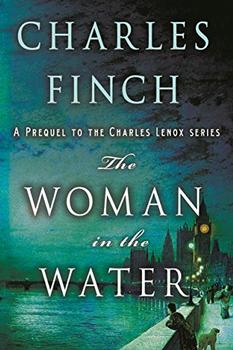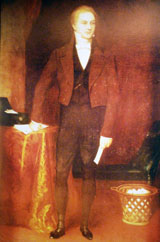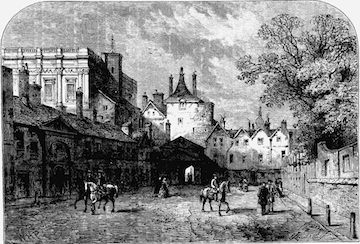Summary | Excerpt | Reviews | Beyond the Book | Read-Alikes | Genres & Themes | Author Bio

A Prequel to the Charles Lennox Series
by Charles FinchThis article relates to The Woman in the Water
In Charles Finch's The Woman in the Water, set in 1850, amateur private detective Charles Lenox works closely with Scotland Yard to solve a pair of murders. At twenty-three, he is barely older than the law enforcement agency.
 Established in 1829 by an Act of Parliament introduced by then Home Secretary Sir Robert Peel, the London Metropolitan Police replaced an old system of watchmen and local police that primarily focused on preventing theft from the many docks along the banks of the River Thames. Colonel Charles Rowan and Richard Mayne, the first Joint Commissioners, were charged with the responsibility of organizing the nascent agency and set up their office in a private house at 4 Whitehall Place. The back entrance to the building was on Great Scotland Yard--which is believed to have got its name because, in past times, it was the location of a building that housed visiting Scottish dignitaries (essentially, a defacto embassy before such things officially existed). Later, this back entrance to 4 Whitehall Place became the public entrance to London's new police headquarters.
Established in 1829 by an Act of Parliament introduced by then Home Secretary Sir Robert Peel, the London Metropolitan Police replaced an old system of watchmen and local police that primarily focused on preventing theft from the many docks along the banks of the River Thames. Colonel Charles Rowan and Richard Mayne, the first Joint Commissioners, were charged with the responsibility of organizing the nascent agency and set up their office in a private house at 4 Whitehall Place. The back entrance to the building was on Great Scotland Yard--which is believed to have got its name because, in past times, it was the location of a building that housed visiting Scottish dignitaries (essentially, a defacto embassy before such things officially existed). Later, this back entrance to 4 Whitehall Place became the public entrance to London's new police headquarters.
According to Finch, "Over time it [that street] had become known, at first casually, as Scotland Street; then Great Scotland Street; then...Scotland Yard." Thus, the label took hold and to this day, despite having no connection whatever to Scotland and having moved several times, the words Scotland Yard are synonymous with the headquarters of the London Metropolitan Police (often referred to as the Met).The only capitulation to modernity, and despite several subsequent location changes, the headquarters is now formally known as New Scotland Yard.
 The very first uniformed police officers to hit London streets were nicknamed "peelers" and "bobbies," both coined as nods to Home Secretary, Sir Robert Peel; bobbies lives on today as colloquial term for police officers across Britain.
The very first uniformed police officers to hit London streets were nicknamed "peelers" and "bobbies," both coined as nods to Home Secretary, Sir Robert Peel; bobbies lives on today as colloquial term for police officers across Britain.
The early police officers wore an eight button tail coat, a top hat and a four inch leather stock inside a high collar (to protect against strangulation). Top hats gave way to military style helmets in 1865 (a variation of which are still worn today).
The only weapon regularly carried by a police officer, both then and now, is a truncheon, to be used only in extremis.
By the time our protagonist Charles Lenox started plying his trade as an amateur detective, uniformed police officers were supplemented by plainclothes officers. Initially, these plainclothes officers were thought to be "spies" and viewed with suspicion by the public at large. However, as serious crime rates dropped and especially after the Crime Investigation Department (CID) was formed in 1878, the dye was cast.
As of January 2017, the Met comprised over 43,000 officers and staff. There were 31,075 officers, 8,732 police staff, 1,464 police community support officers, and 2,763 special constables. Today they serve more than eight million people over 620 square miles within 32 boroughs in Greater London, excluding the City of London which has its own police force.
 Noted for using state of the art forensic techniques in crime investigation, The Met is also responsible for detection and prevention of crime, the preservation of public order, the supervision of road traffic, the licensing of public vehicles and safeguarding visiting dignitaries. As it approaches two centuries of service, New Scotland Yard holds an esteemed rank among law enforcement agencies worldwide as well as a strong appeal to mystery writers from Charles Dickens to Charles Finch.
Noted for using state of the art forensic techniques in crime investigation, The Met is also responsible for detection and prevention of crime, the preservation of public order, the supervision of road traffic, the licensing of public vehicles and safeguarding visiting dignitaries. As it approaches two centuries of service, New Scotland Yard holds an esteemed rank among law enforcement agencies worldwide as well as a strong appeal to mystery writers from Charles Dickens to Charles Finch.
Sir Robert Peel, courtesy of www.open.ac.uk
Scotland Yard circa 1720, courtesy of www.british-history.ac.uk
New Scotland Yard sign
Filed under Society and Politics
![]() This "beyond the book article" relates to The Woman in the Water. It originally ran in April 2018 and has been updated for the
January 2019 paperback edition.
Go to magazine.
This "beyond the book article" relates to The Woman in the Water. It originally ran in April 2018 and has been updated for the
January 2019 paperback edition.
Go to magazine.






Your guide toexceptional books
BookBrowse seeks out and recommends the best in contemporary fiction and nonfiction—books that not only engage and entertain but also deepen our understanding of ourselves and the world around us.